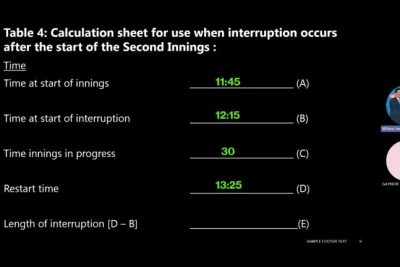Limited overs cricket, a thrilling and action-packed format of the game, has taken the cricketing world by storm. With its fast-paced nature, shorter match durations, and explosive batting displays, it has captivated fans worldwide. From nail-biting finishes to jaw-dropping sixes, limited overs cricket offers a spectacle that keeps spectators on the edge of their seats. In this article, we delve into the essence of this enthralling format, exploring the evolution, tactics, and iconic moments that have made limited overs cricket a true gem in the sporting world.
What is the number of overs in limited overs cricket?
Limited overs cricket is a thrilling format where each team gets to bat only once. In this fast-paced game, each innings is restricted to a specific number of overs. Typically, a One Day International match consists of fifty overs, allowing teams to showcase their skills and strategies within this limited timeframe. Similarly, List A matches, which are played at the domestic level, have a range of overs between forty and sixty, providing an exciting challenge for players and keeping spectators on the edge of their seats.
The concept of limited overs cricket adds a unique twist to the game. By restricting the number of overs per innings, teams are compelled to be strategic and make the most of their opportunities. One Day Internationals, for instance, emphasize the importance of pacing oneself and scoring runs efficiently within the fifty-over limit. Likewise, List A matches offer a slightly wider range of overs, allowing teams to adapt their gameplay accordingly and keep the excitement levels high throughout the game.
Overall, limited overs cricket brings a thrilling and dynamic element to the sport. With each team batting only once and a set number of overs assigned to each innings, players and spectators alike are treated to an action-packed game filled with strategic moves, explosive shots, and nail-biting finishes. Whether it’s the fifty overs in a One Day International or the forty to sixty overs in List A matches, limited overs cricket never fails to captivate fans and showcase the incredible talent of players in this exhilarating format.
When was the change from ODI to 50 overs?
In 1987, the format of One Day Internationals (ODIs) underwent a permanent change from 60 overs to 50 overs. However, it was the 1992 edition of the ODI World Cup, jointly hosted by Australia and New Zealand, that brought about the biggest changes in the format. This marked a significant shift in the game, as teams were now required to score at a faster pace, leading to more aggressive batting strategies and a greater emphasis on power hitting. The introduction of colored clothing, floodlights, and the iconic white cricket ball further added to the visual spectacle of the game, capturing the attention of fans worldwide.
What does the term entitled overs mean in cricket?
In cricket, entitled overs refer to the full quota of overs that a team is allocated to bowl or bat, regardless of the actual number of overs bowled. For instance, in a One Day International match, each team is entitled to play 50 overs, regardless of whether they are bowled out before completing all the overs. Similarly, in a Twenty20 match, each team is entitled to play 20 overs. This calculation ensures fairness and consistency in the game, as teams are given an equal opportunity to showcase their skills within the designated overs.
Breaking Boundaries: How Limited Overs Cricket Revolutionized the Game
Breaking Boundaries: How Limited Overs Cricket Revolutionized the Game
In the world of cricket, limited overs cricket has brought about a revolution that has completely transformed the game. With its fast-paced, high-scoring matches, limited overs cricket has captivated fans around the globe. The shorter format, typically played over 50 or 20 overs, allows for intense action packed with boundaries, showcasing the power-hitting skills of players. This thrilling style of cricket has not only attracted a wider audience but has also pushed players to innovate and adapt their strategies, breaking the traditional boundaries of the sport.
One of the key factors behind the success of limited overs cricket is its ability to provide instant gratification to both players and spectators. With matches lasting only a few hours, fans are treated to an adrenaline-fueled spectacle where boundaries are hit with astonishing frequency. The fast-paced nature of the game demands quick decision-making and improvisation from players, resulting in breathtaking shots and nail-biting finishes. This has led to increased excitement and engagement, attracting a younger audience who may not have the patience for the longer and more traditional test matches.
Moreover, limited overs cricket has given rise to a new breed of cricketers known for their power-hitting skills. In order to succeed in this format, players have had to develop their ability to hit boundaries consistently and creatively. This has resulted in the emergence of innovative shot-making techniques, such as the “reverse sweep” and the “helicopter shot,” which have become iconic in limited overs cricket. These boundary-hitting skills have not only added a new dimension to the game but have also influenced the strategies employed by teams, leading to higher scores and more thrilling contests.
Overall, limited overs cricket has revolutionized the game by breaking the boundaries of traditional cricket. Its fast-paced nature, high-scoring matches, and power-hitting skills have attracted a wider audience and transformed the sport into a spectacle of entertainment. As this format continues to evolve, it will undoubtedly push players and teams to further innovate, bringing even more excitement and boundary-breaking moments to the world of cricket.
Unleashing the Powerplay: The Dynamic Transformation of Limited Overs Cricket
Unleashing the Powerplay: The Dynamic Transformation of Limited Overs Cricket
Cricket, once known for its traditional and strategic gameplay, has undergone a dynamic transformation with the introduction of limited overs cricket. This fast-paced format unleashes the powerplay, igniting a thrilling display of skill, strategy, and sheer aggression on the field. In this electrifying spectacle, batsmen fearlessly take on bowlers, hitting boundaries with unparalleled precision, while bowlers push the limits of their craft to devise innovative tactics. Limited overs cricket has redefined the sport, captivating fans worldwide with its explosive action and unforgettable moments.
Gone are the days of slow-paced innings building and cautious shot selection. Limited overs cricket has revolutionized the game, pushing players to their limits and encouraging an aggressive brand of cricket. The powerplay period, where only a limited number of fielders are allowed outside the 30-yard circle, creates an intense atmosphere where batsmen go all out to maximize their runs. This thrilling format not only tests players’ skills but also captivates spectators, who are treated to a relentless display of boundaries, high-scoring chases, and nail-biting finishes. The dynamic transformation of limited overs cricket has undoubtedly unleashed a new era of excitement and entertainment, forever changing the way the game is played and enjoyed.
Limited overs cricket has undoubtedly revolutionized the game, captivating fans worldwide with its explosive nature and thrilling encounters. With its fast-paced action, nail-biting finishes, and star-studded line-ups, this format has established itself as a catalyst for the sport’s evolution. As teams continue to push boundaries and spectators eagerly await the next boundary or wicket, it is clear that limited overs cricket has not only reinvigorated the game but also secured its place as a modern spectacle that will continue to enthrall generations to come.


